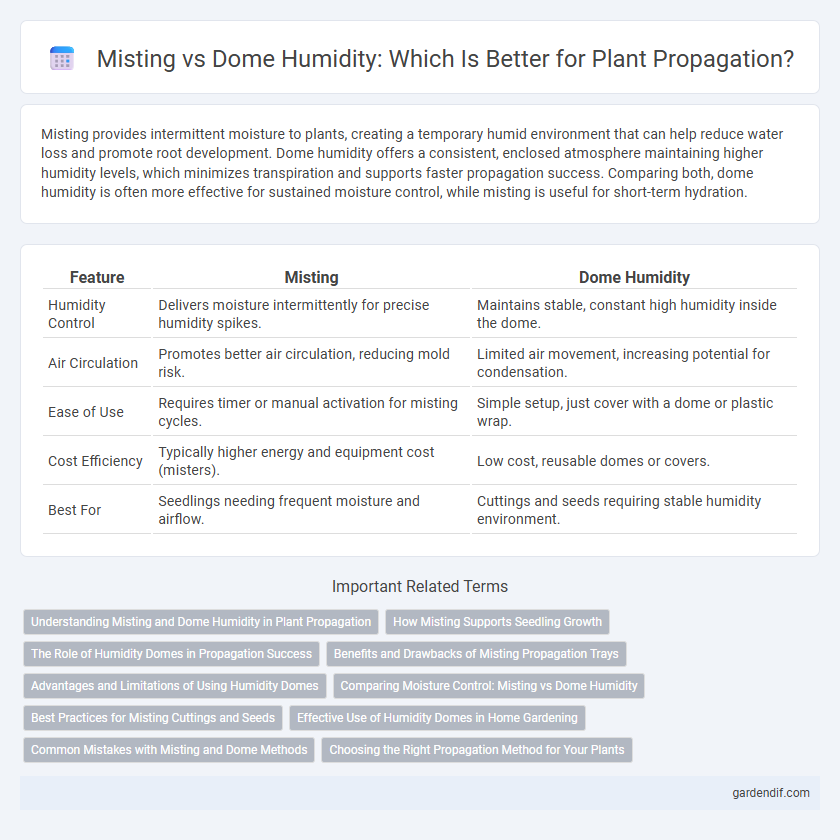
Misting vs dome humidity Illustration
Misting provides intermittent moisture to plants, creating a temporary humid environment that can help reduce water loss and promote root development. Dome humidity offers a consistent, enclosed atmosphere maintaining higher humidity levels, which minimizes transpiration and supports faster propagation success. Comparing both, dome humidity is often more effective for sustained moisture control, while misting is useful for short-term hydration.
Table of Comparison
| Feature | Misting | Dome Humidity |
|---|---|---|
| Humidity Control | Delivers moisture intermittently for precise humidity spikes. | Maintains stable, constant high humidity inside the dome. |
| Air Circulation | Promotes better air circulation, reducing mold risk. | Limited air movement, increasing potential for condensation. |
| Ease of Use | Requires timer or manual activation for misting cycles. | Simple setup, just cover with a dome or plastic wrap. |
| Cost Efficiency | Typically higher energy and equipment cost (misters). | Low cost, reusable domes or covers. |
| Best For | Seedlings needing frequent moisture and airflow. | Cuttings and seeds requiring stable humidity environment. |
Understanding Misting and Dome Humidity in Plant Propagation
Misting provides fine water droplets that help maintain leaf moisture and reduce transpiration, promoting successful rooting in propagation. Dome humidity creates a controlled microenvironment by trapping moisture and increasing relative humidity around cuttings, which minimizes water loss and encourages root development. Both methods optimize hydration levels crucial for healthy plant propagation by balancing moisture retention without causing oversaturation.
How Misting Supports Seedling Growth
Misting enhances seedling growth by providing consistent moisture that promotes optimal hydration without waterlogging the soil, which is essential for delicate root development. Unlike dome humidity that creates a static, enclosed environment, misting ensures better air circulation, reducing the risk of fungal diseases such as damping-off. This dynamic moisture delivery supports stronger, healthier seedlings by maintaining ideal humidity levels and facilitating gas exchange.
The Role of Humidity Domes in Propagation Success
Humidity domes create a controlled microenvironment that maintains high humidity levels, essential for reducing water loss from cuttings during propagation. This stable moisture environment promotes faster root development and minimizes transplant shock compared to misting systems, which can cause variable humidity and risk fungal growth. By sustaining consistent humidity, domes improve overall propagation success rates and seedling vigor.
Benefits and Drawbacks of Misting Propagation Trays
Misting propagation trays provide consistent moisture levels by delivering fine water droplets directly to plant cuttings, which enhances rooting success and reduces transplant shock. However, misting can lead to surface water accumulation, increasing the risk of fungal diseases and requiring frequent monitoring to prevent overwatering. Compared to dome humidity systems, misting offers better air circulation but may need more energy and maintenance to maintain ideal propagation conditions.
Advantages and Limitations of Using Humidity Domes
Humidity domes provide consistent moisture retention, creating a stable microenvironment that promotes faster seed germination and reduces water loss compared to misting systems. They limit airflow, which can increase the risk of fungal diseases and mold growth if not properly ventilated. While domes are effective for maintaining high humidity, their limited air circulation requires careful monitoring to prevent overheating and pathogen development.
Comparing Moisture Control: Misting vs Dome Humidity
Misting provides precise, controlled moisture through fine water droplets that enhance air circulation and prevent waterlogging during propagation. Dome humidity relies on enclosed environments to maintain consistent humidity levels but may cause reduced airflow and increased risk of mold. Comparing moisture control, misting offers dynamic regulation suited for sensitive cuttings, while dome humidity ensures stable moisture retention for hardier plant varieties.
Best Practices for Misting Cuttings and Seeds
Misting cuttings and seeds requires maintaining optimal humidity levels between 70-90% to prevent desiccation and promote root development. Dome humidity often creates a stable microenvironment but can lead to excess moisture and fungal growth if not ventilated properly. Best practices involve fine misting with a spray bottle multiple times daily while ensuring airflow to balance moisture and reduce disease risk.
Effective Use of Humidity Domes in Home Gardening
Humidity domes create a controlled microenvironment that maintains consistent moisture levels, promoting rapid root development in cuttings and seedlings. Unlike misting, which requires frequent reapplication and may cause uneven humidity, domes provide uniform humidity retention, reducing water stress and preventing desiccation in fragile plants. Effective use of humidity domes involves monitoring condensation and ventilation to balance humidity and airflow, optimizing propagation success in home gardening.
Common Mistakes with Misting and Dome Methods
Common mistakes with misting include over-wetting, which causes fungal growth and root rot, and inconsistent mist timing that stresses young cuttings. Dome humidity errors often involve inadequate ventilation, leading to excessive moisture buildup and mold development. Maintaining balanced moisture levels and ensuring proper air circulation are crucial for successful propagation using misting or dome methods.
Choosing the Right Propagation Method for Your Plants
Misting provides targeted moisture that encourages root growth by maintaining consistent leaf hydration, ideal for cuttings sensitive to overwatering. Dome humidity offers a controlled microenvironment with elevated humidity levels, reducing transpiration and promoting overall health in fragile seedlings. Selecting the right propagation method depends on plant species' moisture requirements and susceptibility to mold or rot under high humidity conditions.
Misting vs dome humidity Infographic

 gardendif.com
gardendif.com